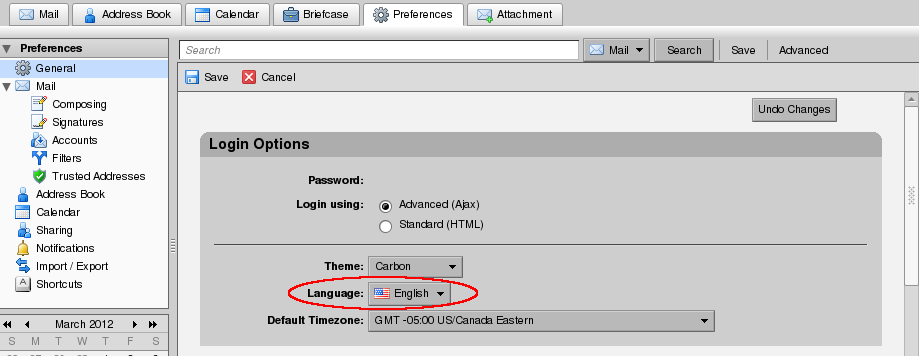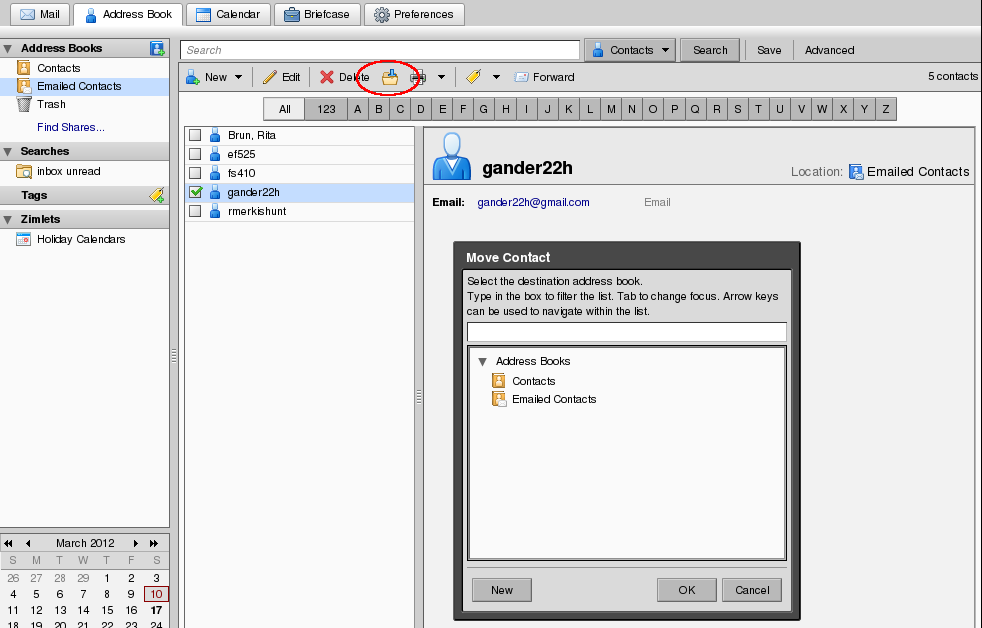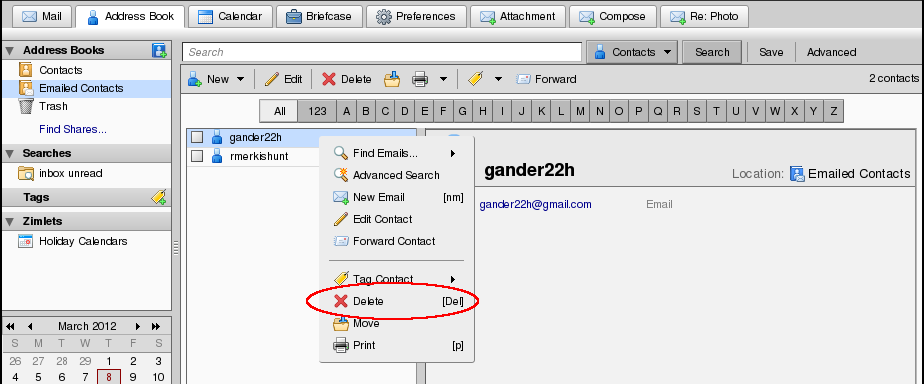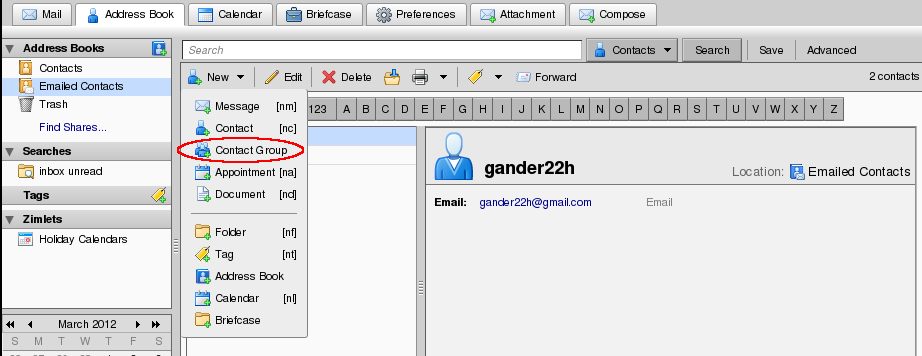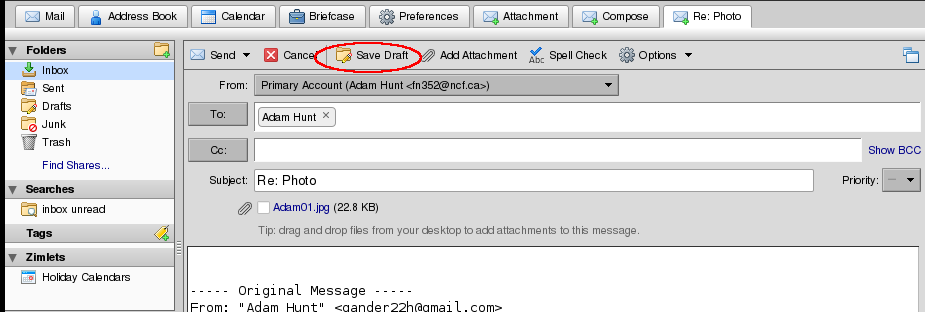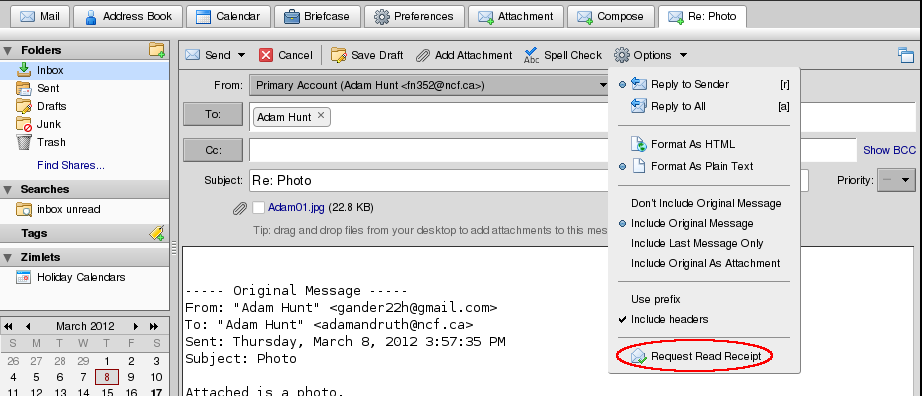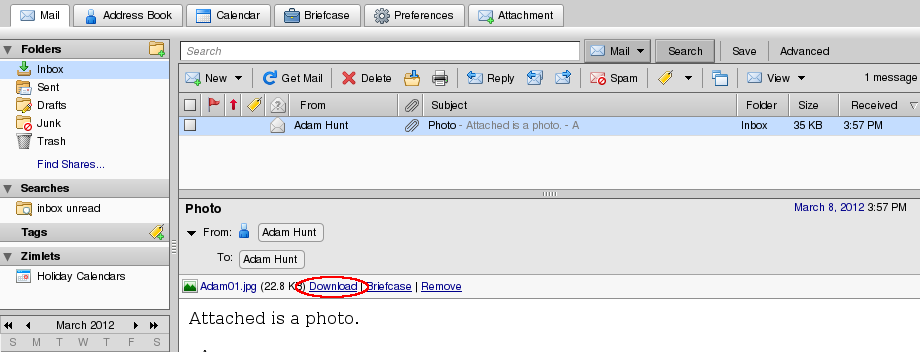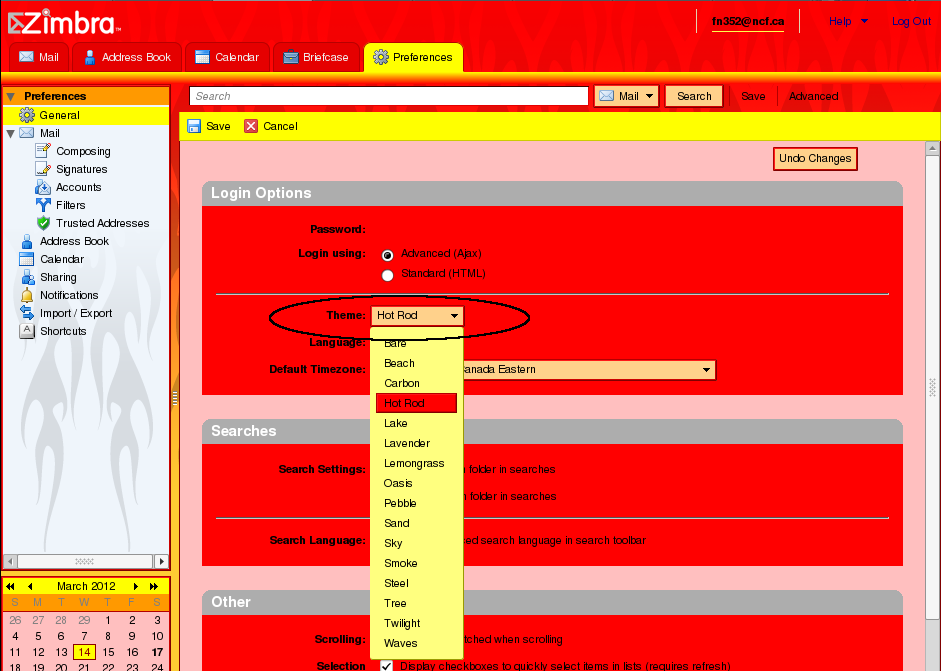Difference between revisions of "Zimbra 7"
(→Downloading attachments: added image, moved text down) |
|||
| Line 210: | Line 210: | ||
===Zimbra indicates an attachment but the e-mail doesn't have one=== | ===Zimbra indicates an attachment but the e-mail doesn't have one=== | ||
Zimbra may sometimes indicate an attachment is present when the sender has embedded a small file in the e-mail, like an emoticon. When the receiver tries to locate the attachment it seems to be missing, but it is actually there, embedded in the e-mail. ;-) | Zimbra may sometimes indicate an attachment is present when the sender has embedded a small file in the e-mail, like an emoticon. When the receiver tries to locate the attachment it seems to be missing, but it is actually there, embedded in the e-mail. ;-) | ||
In the example below Zimbra shows an attachment, but the e-mail only has embedded emoticons. | |||
[[File:Zimbra attachments emoticons.png]] | [[File:Zimbra attachments emoticons.png]] | ||
Revision as of 14:38, 15 March 2012
Zimbra is a free, open source software webmail system that was developed by VMware of Palo Alto, California. Zimbra was extensively tested at NCF during 2011 and rolled out as NCF's new e-mail system in February, 2012.
Zimbra replaced the old "Messenger Express" interface which was becoming unsupportable and also which did not support modern mobile devices, such as smart phones and tablets very well.
The Zimbra mail system provides many features not previously available at NCF. For a brief rundown of some of those features, read the Introduction to Zimbra page.
Accessing the Zimbra Web Client
The Zimbra Web Client can be accessed by clicking on Get Your NCF Webmail on the NCF Startpage.
The standard webmail features are all there - read, reply, and compose email, and manage addresses. However, Zimbra has much more to offer.
There are three versions of Zimbra:
- Standard - for users with slow connections such as dial-up (no spell-checking)
- Advanced - for users with highspeed (with spell-checking that can be enabled at "Preferences→Mail→Composing→Mandatory spellcheck")
- Mobile - for phones, tablets and other mobile devices using 3G and other phone networks for connection
You can select between standard and advanced versions at Zimbra Preferences→General→Login Options.
Zimbra should automatically detect mobile devices and provide the mobile version to them.
Help files
Zimbra includes a large number of built-in help files that explain many features and how they work, which can be found at "Help".
Zimbra doesn't look right
If the Zimbra webmail interface doesn't look right, with elements overlapped, "squashed" or interferring with each other, the problem is likely that you are using a very old browser, such as Internet Explorer 6, 7 or 8, Firefox 3 or similar old browsers. Zimbra has a modern web-standards-compliant interface and will display properly in modern standards-compliant browsers, such as Internet Explorer 9. It has also been tested and works very well in the current versions of the following browsers:
All of these are recommended for use with Zimbra.
I can't find my messages, or I can't see the message size!
Zimbra by default groups messages into conversations, just like Google's Gmail does. This is called "By Conversation" and can be confusing to people who have not used this before. In some cases, you won't see as much detail for each message.
In conversation view you can expand a conversation (collection of related e-mails) to see the individual e-mails, by just double clicking them. You can then restore them to a single conversation by clicking "Inbox" again. Conversation view actually works quite well once you get used to it.
If you are having trouble with conversation view, try changing the view to the more traditional "By Message" view.
Language
Zimbra enables a number of language choices at "Perferences→General→Login Options".
Spelling
The advanced version of Zimbra includes spell-checking, which can be selected on at "Preferences→Mail→Composing→Mandatory spellcheck"
Users with slow connections, using the standard version of Zimbra, who desire spell checking should use a browser that provides built-in spell checking, such as:
or basically any modern browser except Microsoft Internet Explorer.
Adding Calendars
By default, your Zimbra account has a single calendar, named "Calendar". You might want to add some basic things, like Canadian or US holidays, or maybe you have a Google calendar you'd like to view.
For step-by-step instructions on adding calendars, visit:
Contact and Calendar Sync
Zimbra provides CalDAV and CardDAV services for 2-way synchronization of Contacts and Calendards. This allows you to benefit from network-accessible calendars viewable in the Zimbra web client while still using your favourite native clients.
Examples of clients that support CalDAV (for calendar sync):
- Mozilla Thunderbird (with the Lightning calender extension)
- Mozilla Sunbird
- Apple iCal
- Apple iPhone, iPad, iPod
- Evolution
Unfortunately, Microsoft Outlook does not include support for CalDAV. Windows users will need to use a specialized calendar app (eg. Mozilla Sunbird), or consider switching to Mozilla Thunderbird.
Examples of clients that support CardDAV (for contacts sync):
- Mozilla Thunderbird (w/Zindus extension)
- Apple Address Book
- Apple iPhone, iPad, iPod
- Evolution
Client Configuration
Generally, the details are as follows.
CardDAV URL:
https://mail.ncf.ca/dav/ab123@ncf.ca/Contacts
CalDAV URL:
https://mail.ncf.ca/dav/ab123@ncf.ca/Calendar
Note that the final bit of the URL is important, it denotes the name of the Contact or Calendar folder. If you have a Contact folder named "Work", the URL would be:
https://mail.ncf.ca/dav/ab123@ncf.ca/Work
If you have a Calendar named "Soccer Practice", the URL would be:
https://mail.ncf.ca/dav/ab123@ncf.ca/Soccer Practice
Step-by-step Instructions
Zimbra address book
Zimbra includes an address book with no limits on the number of addresses you can enter.
See Zimbra: Thunderbird Contacts for information on synchronizing lists of contacts in Thunderbird and Zimbra using the Zindus add-on.
Moving contacts
Every e-mail address that you exchange e-mail with will be automatically saved under "Emailed contacts". You can leave them there or transfer them to your "Contacts" address book by going to Address book→Emailed contacts→ Check name to be move→"Move selected item" (folder with arrow icon)>select address book.
Deleting contacts
To delete contacts in Zimbra just go to "Address Book→Emailed Contacts (or Contacts)→right click" on the desired email address and select "delete". Alternatively you can also check the contact to be deleted and then click "delete".
Composing an e-mail with formatting
E-mails can be composed in plain text or in HTML. HTML allows underlining, bold text, changing text size and font and other formatting to be used. To select HTML as your default for composing an e-mail go to "Preferences→Mail→Composing".
Adding addresses to a message
In Zimbra addresses can be added to an outgoing e-mail message by typing the address in manually or by clicking on "To", "CC" or "Show BCC" and then "BCC", which opens your address list and allows selecting the addresses.
Adding groups of addresses to a message
Adding a group of contacts to an email is easy in Zimbra. First create a contact group, by going to "Address Book→Emailed Contacts (or Contacts)" and then select "New→down arrow→Contact Group" and complete the form to select members and name for your group. When composing an email you may now select the group as if it were a single address, by clicking "To", "CC" or "BCC" in the email.
Saving and sending drafts
Zimbra allows saving partially completed emails so you can work on them and send them later. When you are ready to save, just click "Save Draft". When you want to work on the email again select the "Drafts" folder, double click on the email and it will open for editing. When you are ready to send it just click "Send", or "Save Draft" again to continue working on it later.
Adding attachments
Adding an attachment is very simple in Zimbra. In the message composition view just click on "Add Attachment" and select where the attachment is to be added from your computer, your briefcase or your contacts. When located click "attach" and the attachment will be sent with the e-mail.
Once attached, an attachment can be omitted from being sent with the e-mail by simply unchecking the attachment in the message composition view.
Requesting e-mail receipts
Zimbra has the capability to request receipts from the person receiving the e-mail. To enable this for a specific e-mail being composed, while editing the e-mail go to "Options→Down Arrow→Request Read Receipt".
Using aliases
Zimbra allows a registered Email Alias. When composing a message simply click the down arrow under "from" and select which address Zimbra should show the message as coming from.
Using NCF disposable e-mail addresses
Disposible e-mail addresses that you create on the NCF website can then be managed in Zimbra from Preferences→Accounts.
Changing your "from" name used in outgoing e-mail
Zimbra allows changing who the e-mail is from, so you can show only your first name, last name or any other text you like. To select this in Zimbra just go to "Preferences→Accounts→Primary Account Settings" and enter your preferred text.
Searching
One of Zimbra's strongest features is its ability to find e-mail, people in your address book, briefcase items and other things using its built-in search function. No more manually poring though your inbox, sent message lists or trash for messages!
To search for something just enter the search term (for example, an e-mail address) in the search box on any page. Select where you want to search on the pull-down menus (All Item types, Mail, Contacts, Appointments, Files and can include shared items) and then click "search".
Searches you want to run again in the future can also be saved, by just clicking "save".
The "Advanced" button gives access to more advanced search features, allowing you to narrow down a search by date, domain, flagged status, etc. To cancel the advanced search just click the "Advanced" button a second time.
Searching for unread messages
Zimbra makes it easy to list your unread messages. In the Zimbra mail search box enter "in:inbox is:unread" and this will show all unread messages in your inbox.
You can also click on 'Save' to save the search, and call it "Inbox Unread". Next time you want this search view, I just click on "Inbox Unread" under saved searches.
Attachments
Downloading attachments
When an e-mail arriving in Zimbra includes an attachment this may be downloaded and then opened by reading the e-mail and then in that view at the top of the e-mail, between the addresses and the text, by clicking on "Download". You can also choose to "Remove" it from the e-mail or send it to the "Briefcase" for saving or sharing.
Zimbra indicates an attachment but the e-mail doesn't have one
Zimbra may sometimes indicate an attachment is present when the sender has embedded a small file in the e-mail, like an emoticon. When the receiver tries to locate the attachment it seems to be missing, but it is actually there, embedded in the e-mail. ;-)
In the example below Zimbra shows an attachment, but the e-mail only has embedded emoticons.
Saving messages
NCF provides 200 MB of storage with your e-mail account. For the average user this is probably enough for three months worth of mail, so you may want to keep some mail and delete other items. Some members have been storing mail they want to keep in their "Trash" file. Even though the trash file does not count towards your 200 MB, the problem with doing this is that if you empty the trash than it is gone. It may make more sense to save the e-mail that you want to keep in a new folder.
New folders are easy to create, just click on the new folder icon in the folder pane, as shown and then name it and decide where to put the new folder in relation to the existing folders. The illustration below shows where to click to create a new folder and shows a new custom folder that was created called "Archive".
By right clicking on any existing e-mail message you can select "Move" and send it to your new folder for safe keeping.
Spam handling
The current NCF implementation of Zimbra has the spam control, found at "Preferences→Mail", disabled so that email messages will not be delivered to Junk folders, or otherwise blocked when sent through from yellowmail.
Mini calender
By default Zimbra shows a mini calendar in its bottom left corner. If you want to turn this off you can at "Preferences→Calender→Always Show the Mini Calender - uncheck".
I don't like the way Zimbra looks
Then change it. Zimbra has 16 themes you can choose from, ranging from dull and serious, to whimsical, to bold, like the Hot Rod theme shown below. Next time you sign in Zimbra will remember your preferences and display your chosen theme.
To select a new theme go to Perferences→General→Login Options→Theme and chose one from the pull-down menu. They mostly look like what they sound like.
Incidentally if you try them all and forget which one is the basic default theme, it is called Carbon.
Why is it called that?
Rumour has it that Zimbra webmail and the Zimbra Collaboration Server is named for the Talking Heads song I Zimbra and that the song is in turn an adaptation of Dada poet Hugo Ball's poem "Gadji beri bimba."
See also
- Email - configuring e-mail clients for POP and other general e-mail information
Other pages with information about the Zimbra mail client:
- Introduction to Zimbra - the basics and how-to screenshots
- Zimbra: Google Calendar - information on using Google calendars in Zimbra
- Zimbra: Thunderbird Calendar - information on importing a calendar from Zimbra to Thunderbird
- Zimbra: Thunderbird Contacts - information on synchronizing lists of contacts in Thunderbird and Zimbra using the Zindus add-on.






